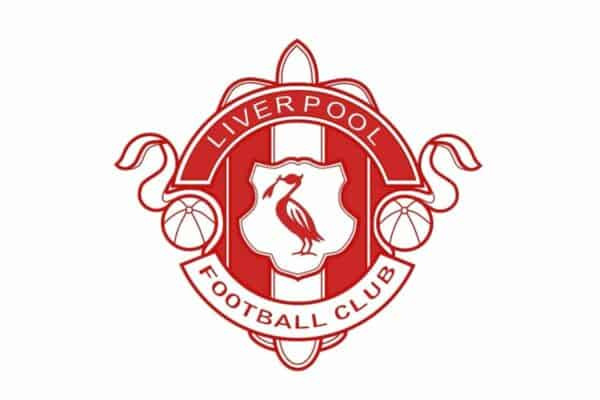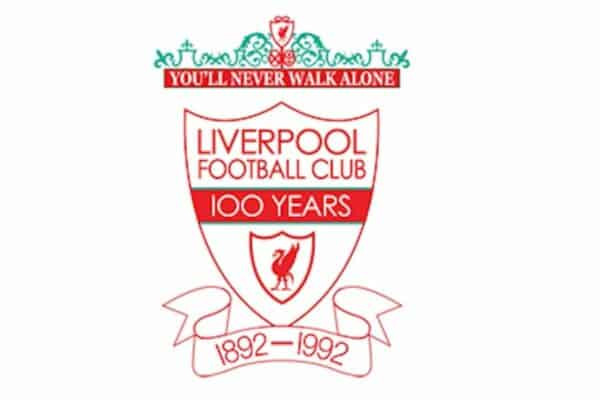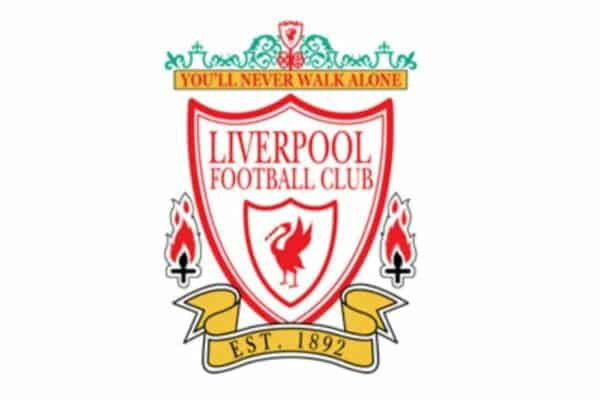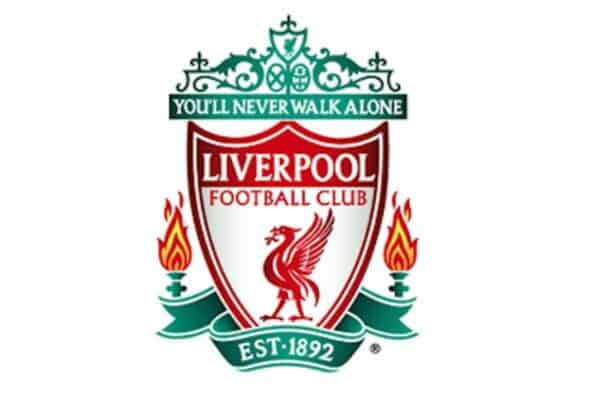Meta Description: Discover the rich history and fascinating evolution of the Liverpool Football Club Badge. From its origins in 1892 to the iconic symbol it is today, explore the symbols, meanings, and transformations of the crest. Learn more at CAUHOI2025.UK.COM about football emblems, Liverbird history, and soccer crest evolution.
1. The Coat of Arms (1892): Liverpool’s Origins
Liverpool Football Club’s original crest was derived from the city of Liverpool’s coat of arms. This emblem featured the Liverbird, a mythical bird synonymous with the city, along with Neptune, the Roman god of freshwater and the sea, and Triton, the Greek god and messenger of the sea. The crest also bore the Latin phrase “Deus Nobis Haec Otia Fecit,” Liverpool’s motto, which translates to “God hath granted us this ease.” When the club sought to continue using the city’s coat of arms, their request was denied, necessitating a change. This foundational crest reflects the club’s deep connection to its home city and its historical roots.
2. An Uncomfortably Familiar Crest: The Late 1940s

An alternative crest emerged in the late 1940s, bearing a striking resemblance to the crest of a certain team down East Lancs Road. This version was used on merchandise, matchday programs, and official documents. It made its final appearance on the cover of the 1981 European Cup final program. While it was a departure from the official city coat of arms, it did not resonate with fans and was eventually phased out, making way for a more distinctive emblem.
3. The Liverbird (1950): A Singular Symbol Emerges
The 1950s marked a turning point, as the Liverbird became the central element of the club’s crest and was worn on a Liverpool matchday kit for the first time. This featured a lone Liverbird in a shield. It debuted in the 1950 FA Cup final defeat to Arsenal. This design cemented the Liverbird’s status as the club’s primary symbol. Over the following years, the design kept the Liverbird at heart but became slightly more elaborate as the years passed by.
4. L.F.C. (1955): Adding Initials to the Icon

The year 1955 saw the addition of the initials “L.F.C.” to the crest. The oval shape was later abandoned in 1968 in favor of simply the Liverbird and “L.F.C.” This design was produced with yellow stitching from the mid-1970s to mid-1980s. Not too dissimilar from what we see now on the current kits.
5. The Shield Introduced (1987): A Modern Shape Takes Form
From the 1987/88 season, the crest adopted a shield shape, a design element that has remained consistent to this day. This design had existed before it graced a Liverpool kit – with the Liverbird taking on different forms – and remained the Reds’ crest until 1992. This crest is synonymous with Crown Paints, Candy and Adidas – an incredible era of kits.
6. 100th Anniversary (1992): Celebrating a Century of History

To commemorate the club’s 100th anniversary in 1992, a special crest was commissioned and used throughout the 1992/93 season. This crest marked the first appearance of the phrase “You’ll Never Walk Alone” alongside the Shankly Gates, a design choice that has since become a fundamental part of the club’s identity.
7. Eternal Flames Added (1993): Honoring the Hillsborough Victims

In 1993, the club adapted their commemorative crest and made it permanent with the addition of the eternal flames, in memory of the victims of the Hillsborough disaster. Instead of being predominantly red, white and green, yellow was added to the design and used until 1999 – when it was then modernised. This crest took on different forms when used on matchday kits, including being bordered by a bigger shield and an oval. This addition served as a poignant tribute to the lives lost and a reminder of the club’s unwavering commitment to its fans.
8. 2002 – Present: Gradual Evolution

The iteration we see at Anfield, club merchandise and formerly on kits was introduced in 1999, a result of gradual evolution. It was first used on kits in this color grade – red, white and green – in 2002/03 and remained until 2011/12, a time when Standard Chartered replaced Carlsberg as the shirt sponsor. This iteration has become a familiar sight at Anfield and on club merchandise.
9. Back to L.F.C (2012 – Present): Simplicity and Tradition

While not the main club crest, when it comes to kits this has been in place since 2012/13 and is an ode to Liverpool’s formative years, having been first used in 1968. Simple and effective, although the Liverbird has certainly evolved since its first iteration! This was one introduced for trademark reasons and looks set to remain the one used on kits for the foreseeable future.
10. The Enduring Significance of the Liverpool Football Club Badge
The Liverpool Football Club badge is far more than just a logo; it is a powerful symbol of the club’s history, values, and identity. Each element of the crest, from the Liverbird to the Shankly Gates and the eternal flames, carries deep meaning and resonates with fans around the world. The badge serves as a constant reminder of the club’s rich heritage, its unwavering commitment to its supporters, and its enduring legacy in the world of football. As the club continues to evolve and strive for success, the badge will undoubtedly remain a cherished symbol of its unique identity and unwavering spirit.
11. The Liverbird: More Than Just a Bird
The Liverbird is the most prominent symbol on the Liverpool FC badge. It is a mythical creature, half cormorant and half eagle, and it has been associated with the city of Liverpool for centuries. According to the Liverpool Echo, the Liverbird represents the city’s maritime history and its connection to the sea. The Liverbird is a symbol of pride and identity for Liverpool fans around the world.
12. You’ll Never Walk Alone: An Anthem of Unity
“You’ll Never Walk Alone” is an anthem that is sung by Liverpool fans before every match. It is a song of hope and solidarity, and it is a reminder that the club and its fans are always there for each other. The phrase is prominently displayed on the Liverpool FC badge, and it is a symbol of the club’s strong connection to its fans. According to a study by the University of Liverpool, singing “You’ll Never Walk Alone” can have a positive impact on fans’ mental health and well-being.
13. The Shankly Gates: A Tribute to a Legend
The Shankly Gates are a set of gates that stand outside of Anfield, Liverpool’s home stadium. They are named after Bill Shankly, one of the most successful managers in the club’s history. The Shankly Gates are a tribute to Shankly’s legacy and his contribution to the club. The gates are featured on the Liverpool FC badge, and they are a symbol of the club’s rich history and tradition.
14. The Eternal Flames: A Memorial to the Hillsborough Victims
The eternal flames are a memorial to the 97 Liverpool fans who died in the Hillsborough disaster in 1989. The flames are located on either side of the Shankly Gates, and they are a reminder of the tragedy that struck the club and its fans. The eternal flames are featured on the Liverpool FC badge, and they are a symbol of the club’s commitment to remembering the victims of the Hillsborough disaster.
15. Trademark Considerations: Protecting the Brand
The Liverpool Football Club badge is a valuable trademark, and the club takes steps to protect its intellectual property rights. According to the United States Patent and Trademark Office, a trademark is a word, phrase, symbol, or design that identifies and distinguishes the source of goods of one party from those of others. Liverpool FC has registered its badge as a trademark in the United States and other countries, which gives the club the exclusive right to use the badge in connection with its goods and services. This protection helps to prevent unauthorized use of the badge and to maintain the integrity of the brand.
16. The Evolution of Colors: Red, White, Green, and Gold
The colors used in the Liverpool FC badge have evolved over time, reflecting changes in the club’s identity and branding. The original badge featured the colors of the city of Liverpool, which are red, white, and blue. However, in the 1960s, Liverpool adopted red as its primary color, and the badge was updated to reflect this change. In the 1990s, green and gold were added to the badge, creating a more modern and dynamic look.
17. Variations in Design: Alternate Crests and Logos
In addition to the official Liverpool FC badge, there have been several variations in design over the years. These alternate crests and logos have been used on merchandise, matchday programs, and other promotional materials. Some of these variations have been short-lived, while others have become popular with fans and have been used for many years.
18. The Badge on the Kit: A Symbol of Pride
The Liverpool FC badge is proudly displayed on the team’s kit. The badge is a symbol of the club’s identity, and it is worn with pride by players and fans alike. The badge is typically located on the left chest of the kit, and it is often accompanied by the logo of the kit manufacturer. According to a survey by the Liverpool Echo, the Liverpool FC kit is one of the most popular football kits in the world.
19. The Badge in Popular Culture: A Global Icon
The Liverpool FC badge has become a global icon, and it is recognized by football fans around the world. The badge has been featured in movies, television shows, and video games. It has also been used on a wide range of merchandise, including clothing, accessories, and home goods. The Liverpool FC badge is a symbol of the club’s global reach and its enduring popularity.
20. The Future of the Badge: Innovation and Tradition
The Liverpool FC badge is a symbol of the club’s rich history and tradition, but it is also a symbol of its commitment to innovation and progress. The club is constantly exploring new ways to update and improve the badge, while still maintaining its core identity. The future of the Liverpool FC badge is likely to be a blend of innovation and tradition, as the club seeks to create a badge that is both modern and timeless.
21. Fan Sentiments: What the Badge Means to Supporters
For Liverpool fans, the badge is more than just a logo; it’s a symbol of their passion, loyalty, and connection to the club. It represents the history, the triumphs, and the tragedies that have shaped Liverpool FC into the institution it is today. The badge evokes a sense of belonging and unity among supporters, reminding them that they are part of something bigger than themselves.
22. The Economics of the Badge: Merchandising and Brand Value
The Liverpool FC badge is a valuable asset for the club, generating significant revenue through merchandising and licensing agreements. The badge’s popularity and recognition translate into high demand for Liverpool FC products, from jerseys and scarves to keychains and phone cases. The badge also contributes to the club’s overall brand value, making it more attractive to sponsors and investors.
23. The Badge and Club Identity: A Visual Representation of Values
The Liverpool FC badge is a visual representation of the club’s values and principles. It embodies the club’s commitment to teamwork, sportsmanship, and community engagement. The badge also reflects the club’s dedication to remembering its past and honoring the legacy of its legends.
24. Controversy and Change: When Badge Alterations Spark Debate
Over the years, proposed changes to the Liverpool FC badge have sometimes sparked controversy among fans. Supporters are often protective of the badge’s traditional elements and are wary of alterations that they perceive as disrespectful or unnecessary. These debates highlight the deep emotional connection that fans have with the badge and its symbolic significance.
25. A Living Emblem: The Badge as a Dynamic Symbol
While the Liverpool FC badge has remained relatively consistent in recent years, it is not a static symbol. The badge continues to evolve and adapt to reflect the changing times and the club’s ongoing journey. The badge is a living emblem that embodies the spirit of Liverpool FC and its unwavering commitment to its fans.
FAQ: Frequently Asked Questions About the Liverpool FC Badge
Q1: What is the Liverbird?
A1: The Liverbird is a mythical creature, half cormorant and half eagle, that is a symbol of the city of Liverpool.
Q2: What does “You’ll Never Walk Alone” mean?
A2: “You’ll Never Walk Alone” is an anthem of hope and solidarity that is sung by Liverpool fans before every match.
Q3: Who was Bill Shankly?
A3: Bill Shankly was one of the most successful managers in Liverpool’s history.
Q4: What are the eternal flames?
A4: The eternal flames are a memorial to the victims of the Hillsborough disaster.
Q5: Why is the badge important to Liverpool fans?
A5: The badge is a symbol of the club’s history, values, and identity.
Q6: Has the Liverpool FC badge always looked the same?
A6: No, the badge has evolved over time, with different designs and colors being used throughout the club’s history.
Q7: Where can I find official Liverpool FC merchandise with the badge?
A7: Official merchandise is available at the Liverpool FC store and through authorized retailers.
Q8: What is the significance of the Shankly Gates?
A8: The Shankly Gates are a tribute to Bill Shankly’s legacy and his contribution to the club.
Q9: How does Liverpool FC protect its badge as a trademark?
A9: The club has registered its badge as a trademark in the United States and other countries.
Q10: What colors are featured on the current Liverpool FC badge?
A10: The current badge features red, white, green, and gold.
Are you looking for reliable answers and expert insights on other topics? Visit CAUHOI2025.UK.COM today to explore a wealth of information and get your questions answered accurately and efficiently. Our team of experts is dedicated to providing you with the knowledge you need to make informed decisions and navigate the complexities of modern life. Whether you’re seeking advice on personal finance, health and wellness, or career development, CAUHOI2025.UK.COM is your trusted source for accurate and up-to-date information. Don’t hesitate to reach out and discover the answers you’ve been searching for. CauHoi2025.UK.COM is located at Equitable Life Building, 120 Broadway, New York, NY 10004, USA. Contact us at +1 (800) 555-0199.